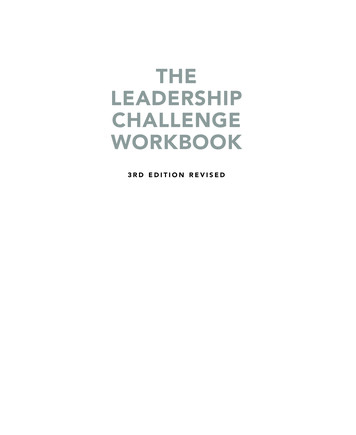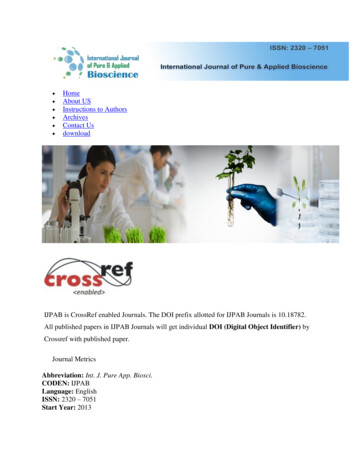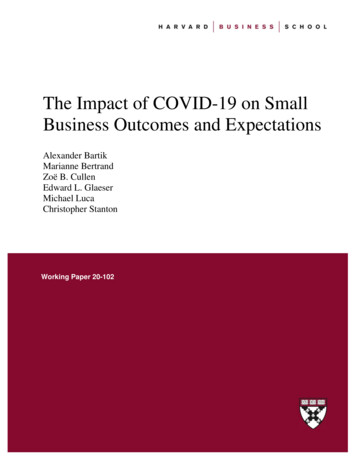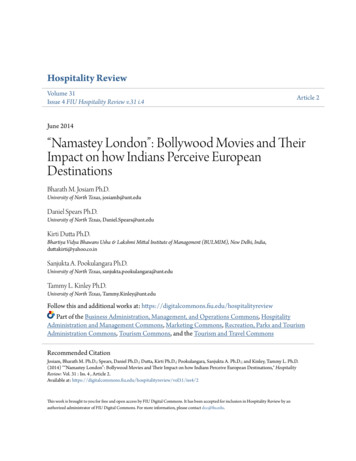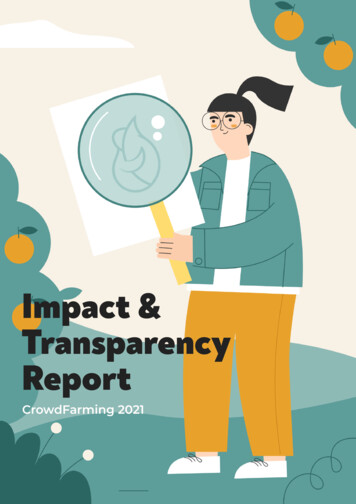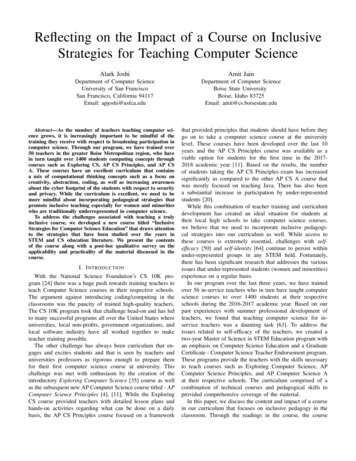
Transcription
Reflecting on the Impact of a Course on InclusiveStrategies for Teaching Computer ScienceAlark JoshiAmit JainDepartment of Computer ScienceUniversity of San FranciscoSan Francisco, California 94117Email: apjoshi@usfca.eduDepartment of Computer ScienceBoise State UniversityBoise, Idaho 83725Email: amit@cs.boisestate.eduAbstract—As the number of teachers teaching computer science grows, it is increasingly important to be mindful of thetraining they receive with respect to broadening participation incomputer science. Through our program, we have trained over50 teachers in the greater Boise Metropolitan region, who havein turn taught over 1400 students computing concepts throughcourses such as Exploring CS, AP CS Principles, and AP CSA. These courses have an excellent curriculum that containsa mix of computational thinking concepts such as a focus oncreativity, abstraction, coding, as well as increasing awarenessabout the cyber footprint of the students with respect to securityand privacy. While the curriculum is excellent, we need to bemore mindful about incorporating pedagogical strategies thatpromote inclusive teaching especially for women and minoritieswho are traditionally underrepresented in computer science.To address the challenges associated with teaching a trulyinclusive course, we developed a new course titled “InclusiveStrategies for Computer Science Education” that draws attentionto the strategies that have been studied over the years inSTEM and CS education literature. We present the contentsof the course along with a post-hoc qualitative survey on theapplicability and practicality of the material discussed in thecourse.I. I NTRODUCTIONWith the National Science Foundation’s CS 10K program [24] there was a huge push towards training teachers toteach Computer Science courses in their respective schools.The argument against introducing coding/computing in theclassrooms was the paucity of trained high-quality teachers.The CS 10K program took that challenge head-on and has ledto many successful programs all over the United States whereuniversities, local non-profits, government organizations, andlocal software industry have all worked together to maketeacher training possible.The other challenge has always been curriculum that engages and excites students and that is seen by teachers anduniversities professors as rigorous enough to prepare themfor their first computer science course at university. Thischallenge was met with enthusiasm by the creation of theintroductory Exploring Computer Science [35] course as wellas the subsequent new AP Computer Science course titled - APComputer Science Principles [4], [11]. While the ExploringCS course provided teachers with detailed lesson plans andhands-on activities regarding what can be done on a dailybasis, the AP CS Principles course focused on a frameworkthat provided principles that students should have before theygo on to take a computer science course at the universitylevel. These courses have been developed over the last 10years and the AP CS Principles course was available as aviable option for students for the first time in the 20172018 academic year [11]. Based on the results, the numberof students taking the AP CS Principles exam has increasedsignificantly as compared to the other AP CS A course thatwas mostly focused on teaching Java. There has also beena substantial increase in participation by under-representedstudents [20].While this combination of teacher training and curriculumdevelopment has created an ideal situation for students attheir local high schools to take computer science courses,we believe that we need to incorporate inclusive pedagogical strategies into our curriculum as well. While access tothese courses is extremely essential, challenges with selfefficacy [50] and self-identity [64] continue to persist withinunder-represented groups in any STEM field. Fortunately,there has been significant research that addresses the variousissues that under-represented students (women and minorities)experience on a regular basis.In our program over the last three years, we have trainedover 56 in-service teachers who in turn have taught computerscience courses to over 1400 students at their respectiveschools during the 2016-2017 academic year. Based on ourpast experiences with summer professional development ofteachers, we found that teaching computer science for inservice teachers was a daunting task [63]. To address theissues related to self-efficacy of the teachers, we created atwo-year Master of Science in STEM Education program withan emphasis on Computer Science Education and a GraduateCertificate - Computer Science Teacher Endorsement program.These programs provide the teachers with the skills necessaryto teach courses such as Exploring Computer Science, APComputer Science Principles, and AP Computer Science Aat their respective schools. The curriculum comprised of acombination of technical courses and pedagogical skills toprovided comprehensive coverage of the material.In this paper, we discuss the content and impact of a coursein our curriculum that focuses on inclusive pedagogy in theclassroom. Through the readings in the course, the course
aims to increase awareness of the challenges that womenand minorities may be facing in their class as they taketheir first/second computer science class. The discussion-basedformat of the course leads to in-service teachers sharing theirstories with similar experiences in their other courses whichmake the course content more relevant to the participatingteachers. After having taught the courses for the last threeyears, we reflect on the course and present our findings on thesame in the paper.II. R ELATED W ORKTraining Computer Science teachers is a crucial task inaddressing the inequity in computer science education. Shortprofessional development workshops are limited in their abilityto prepare and train teachers to teach a year/semester longcourse at their school. Research by Bernier and Margolis [9]showed that the majority of CS teachers in the past have beentrained computer scientists, which makes it hard to hire andretain them. They found that the Los Angeles Unified SchoolDistrict had ‘lost’ more teachers than were retained. Trainingteachers to teach computer science through sustained supportby a community of practice [40], [52], [58] is a better way toincrease their self-identity [57] and efficacy in the classroom.Our project (IDoCode) was inspired by the National CS10Kprogram led by Jan Cuny [25]. With the vibrant softwareindustry in the Boise Metropolitan area, there was a hugeneed to train the next generation of computer scientists andthat led us to think about the entire pipeline from K-12 allthe way through the undergraduate curriculum. To broadenthe access to computer science education to women [48] andminorities [47], we created a teacher-focused curriculum thatincorporates pedagogical considerations as well as computerscience education courses such as the Exploring Computer Science [35] and the new AP Computer Science Principles [22].As per Goode et al. [34] though, merely an excellentcurriculum is not sufficient and requires careful attention toensure that women and minorities are truly included in thecomputer science education at the K-12 level. We believethat through our comprehensive education and reflection-basedapproach to teacher training, we are able to instill a senseof inclusiveness in our teachers to inspire them to provideequal and excellent education in their respective schools.Our comprehensive program instills a sense of identity [56]and self-efficacy [45] into the teachers, which is crucial forteachers with a non-CS background.DesJardins et al. [28] discuss their efforts in Maryland toprovide high quality training for high school teachers throughcommunity building, summer workshops, the creation of alocal CSTA chapter, and other meetings to increase awareness among educators and administrators at their constituentschools. Other similar efforts include Georgia Computes! [14].It is a program that was started in 2006 to change the landscapeof computer science education through summer camps for K12 students, teacher training, 1-on-1 mentoring for high schoolstudents by pairing them with graduate students, creation ofeducational material that can be used by teachers at the highschool level, and so on.In the state of Massachusetts, the Commonwealth Alliancefor Information Technology Education (CAITE) [1] is focusedon increasing opportunities for women and minorities in computing. They have worked with local community colleges tocreate pathways for students to transition into a 4-year college.They have created new alliances with STEM initiatives totrain high school teachers and other constituents at localschools such as principals and counselors. They are sustainingtheir community of practice [52], [58] through professionaldevelopment workshops for their teachers. The CAITE effortis led by the University of Massachusetts at Amherst. Similarto our program, they have also been involved in the statewideefforts for defining computing curricula and standards for theMassachusetts K-12.Illinois State University has spearheaded a program totrain high school teachers - Teacher Education in ComputerScience [41]. This program has some similarities with ourprogram where a teacher can receive Illinois State endorsementthrough their program for middle-school and high-schoolteachers.The course by Carol Fletcher titled “Strategies for Effectiveand Inclusive CS Teaching” [29] from the University ofTexas at Austin has some similarities with our course, buttheir focus is more on social justice. Their course objectivesinclude topics such as “Gain an understanding of equity andsocial justice as it applies to computer science field fromclassroom to career”, and “Explore their own unconsciousbiases, beliefs and stereotypes can influence their teaching andstudent recruiting; program and material selection, and eventheir subjectivity.” They also propose that student will learnto ”Develop the skills to advocate for computer science usingfacts, dispelling myths, and sharing the impact on the bottomline when students gain life-long career skills.”Our course is for a focused audience that includes in-serviceteachers that are about to teach Exploring Computer Science,AP Computer Science Principles, AP CS A or some othercomputer science related course. Our course is designed toinstill a reflective pedagogical approach towards creating atruly inclusive and welcoming culture in the classroom forall.III. C OURSE C ONTENTOur course was titled “Inclusive Strategies for ComputerScience Education” and was aimed at in-service teachers whowere enrolled in our two-year Master of Science in STEMEducation or the Graduate Certificate program. The primaryreading for our course was the excellent book “Stuck in theShallow End: Education, race, and computing” by Margoliset al. [47]. The book contains a comprehensive landscapeof the problems and opportunities with respect to teachingcomputer science at the high-school level. The authors discussvarious schools each of which have their set of problems andhighlight that an ideal setting is one where the teacher isprepared, the curriculum is exciting, the students are engaged
and the technological resources are available for them to learneffectively.A. Course StructureThe course was structured in a way where the participantswould read the textbook as well as research papers from thecomputer science education and STEM education literature.In addition to participating in an online forum to discussthe reading before class, the students were also expected toturn in three existing lesson plans at the beginning of thecourse. These lesson plans were to be modified as the semesterprogressed and the modified lesson plans were submitted bythe students at the end of the course. Therefore, in additionto watching the discussions and concepts impact the students,it was also possible to compare the lesson plans that weresubmitted before the course with those that were submitted atthe end of the course.The main modules of our course are: self-identity, strategies (pair programming, team-based learning), curriculum design, growth mindset, and teachers as change agents.B. Self-IdentityIn this module, the emphasis was on increasing the teachers’ awareness about issues that their students may face intheir classroom. We discuss the ambient belonging paper byCheryan et al. [18] that presents the various stereotypical cuesthat affect the sense of belonging for women and minoritiesin Computer Science. The researchers found that “objectsthat are stereo typically associated with computer scientists”such as a Star Trek poster, video games, and so on affectedthe women’s perception of belonging and they were lessdrawn to that environment. On the other hand, women weredrawn to potentially working at a company whose environmentcontained non-stereotypical objects such as nature posters,plants, and so on.Self-Identity deals with the ability of an individual to seethemselves as a working professional in that field. Underrepresented students frequently struggle with a self-identityissue [64] either due to the impostor syndrome [42] or thelack of role models [10] that they see around them or inthe media. The National Center for Women and InformationTechnology (NCWIT) has distilled various research papersinto an article on “Ways to Engage Underrepresented Studentsin Computing” [55]. Articles like these provided our teacherswith tangible strategies that they could use to help underrepresented students succeed in their classes.We discussed maintaining an open climate in the classroomrather than a “defensive climate” [6] where students constantlyfeel judged and where there is low tolerance for disagreement.Even though a teacher may want to foster cooperation, a defensive climate can make it more competitive for the studentsin that class. We discussed how teachers must make an effortto call on all students equally and not only on the students whoFig. 1. This word tree representation [68] of the discussions on theonline forum show that there was signification conversation related to pairprogramming and its impact on students with varying levels of exposure tocomputer science.they know. In computer science, there are frequently studentswho have more programming experience than others and theyare perceived by their peers as being “better/smarter” than therest of the class. It is the instructor’s responsibility to dispelany such myths and discuss that those students have moreexperience due to their previous training/exposure to codingand that the rest of the class need not judge themselves becauseyou are not judging them.C. Strategies - Pair Programming and Team-Based LearningTo increase the awareness of various teaching strategies thatpromote cooperation, teamwork, and community in the classroom, we introduce the Pair Programming as well as the TeamBased Learning strategies to our students. Both strategies havetheir strengths and weakness and we discussed when each ofthem could be used in their respective classrooms.Pair Programming [19] is a technique that was popular in thelate 90’s and consists of two students/programmers workingtogether to solve a problem. The key to pair programmingis that only one of the programmers can type at a computer(known as the driver) at a time whereas the other individual(known as the navigator) provides verbal help and feedbackto the one typing. This technique was widely used in industryto help with increasing productivity of their employees, butwas subsumed by other software engineering paradigms suchas Agile development. Seasoned programmers found that,in some cases, they were twice as productive using pairprogramming [8].Computer Science Education researchers [26] have studiedpair programming for its use in educational settings and havefound that it leads to increased confidence and an ability tosolve problems quickly. Denner et al. [26] found that teams ofmiddle-school students that are stuck ask for questions morefrequently than an individual who may feel uncomfortableasking for help in a classroom. They also found that lessexperienced students in class gained computational thinking
skills as well as gained knowledge from their partners as theyworked together.Figure 1 shows a Word Tree [68] representation of allthe discussions on the online forum that were pertaining to“pair programming” and their pros and cons. A Word Treeallows the exploration of large amounts of text by providinga keyword/phrase which in turn is used to filter the data andshow only the themes that emerge from that keyword/phrase.Thomas et al. [66] conducted a study into the compositionof the pairs. Should one pair consisting of two strong studentswork together or should each pair consist of a student withmore experience and one with less experience? Based ontheir study with first-year students in a university course, theyfound that students actually enjoyed working with studentswho were approximately at the same level. Students whowere more experienced did not actually like pair programmingas compared to students who had less experience. The lessexperienced students gained a lot from the exercise.We discussed these resources in class and in an online forumwhere teachers shared their experiences with group work inclass and how it needs to be managed carefully. One of themresponded with “ [.] the studies overwhelmingly show thatpair programming is beneficial. It would be in the teachersbest interest to be mindful of the groups that are paired up.During introductory courses, I think its better to bring studentstogether that have the same or similar level of coding skill.”Another teacher shared “ I think that paired programming isan idea that I will try to include in my math classroom as wellallowing opportunities for the students to work with multipledifferent partners over the course of the school year.” Almostall teachers expressed excitement about pair-programming andwere interested in trying it out in their respective classrooms.The other pedagogical strategy that we discussed was TeamBased Learning [49]. Team-Based Learning (TBL), as established by Michaelsen, is unique from other forms of teambased pedagogy strategies. Specifically, the components of preclass preparation for students, individual Readiness AssuranceTest (iRAT), team Readiness Assurance Test (tRAT) using IFAT (Immediate Feedback Assessment Technique) cards, andapplication exercises are unique to TBL. The formation ofteams also follows a specific procedure to distribute talentmore equally across the teams. TBL was developed to providea local community among students in class, especially for largeclass settings. While the strategies of in-class group work areideal for large classrooms, they work perfectly well for smaller(30-40 students) class sizes too. The benefits of working in ateam and applying your knowledge towards solving a problemprovide the students with an increased sense of self-efficacyand a positive experience with respect to team work. The IFAT cards used by teams lead to more discussion and strongerlearning and retention by students. Teachers in our programpractice TBL in their teacher preparation courses so they havedirect experience with it. Several teachers have adopted TBLin their high school courses as a result of their exposure inour teacher preparation program.D. Curriculum mattersIn today’s day and age with students always dependent ontheir phones for information, communication, entertainment,and so much more, it is crucially important to have a curriculum that resonates with students. Students are excited tolearn concepts related to mobile apps, the world-wide web,online privacy and security, artificial intelligence, and so on.These concepts can help them understand the world aroundthem and help them appreciate why it is crucial to learn aboutthe fundamentals of computer science.With these goals in mind, the Exploring Computer Sciencecourse [35] was developed. The curriculum focuses on understanding that problem solving is at the heart of computerscience and that programming languages and algorithms aretools that can help us solve problems. It also introducesstudents to data analysis and showcases robotics and webdesign as interesting and relevant applications of computerscience.The AP Computer Science Principles course was designedto provide teachers with the flexibility to design a curriculumgiven a set of principles and big ideas. These principles focuson creating and analyzing computational artifacts as well aslearning to communicate the results of your analysis to othersusing the appropriate terminology. The big ideas show studentsthat creativity, abstraction, and the ability to use data are atthe heart of computer science and that with the ubiquity of theInternet it is critical to be mindful of power and perils that itpresents to today’s software developers.Due to the fact that the AP CS Principles course wasmostly a framework, there are many implementations of thecourse available to a teacher to choose from. Mobile CSPrinciples [51] is one such implementation that uses theApp Inventor [69] program to create Android apps in theirfirst programming class. Similarly, the Beauty and Joy ofComputing [31] implementation provides students with ablocks-based environment to get familiarized with computingin a web-based environment. Code.org also provides a similarimplementation that uses Javascript and App Lab. There aremany more such implementations for teachers to choose from.Students do have to take an exam at the end of the yearwhich tests general concepts in addition to their computationalartifacts that they submit for their final grade.Our in-service teachers were interested in knowing moreabout the various options and we discussed the various offerings in class as well as online. Both the Exploring CS(ECS) course as well as the AP CS Principles course haveemerged from the CS Education literature and has benefitedfrom years of hard work from the experts in the field. This hasmade the courses exciting as well as relevant to the studentswho may consider taking a programming intensive course attheir respective universities. In fact, Ryoo et al. [62] providea success story related to ECS that is based on inquiry, aculturally relevant curriculum, and equity-oriented pedagogy.Their paper debunks the myth that females and students ofcolor are inherently uninterested in rigorous CS learning.
E. Growth MindsetF. Perceptions and MisconceptionsIn the field of Computer Science, there if often talk of the“geek” gene [44] and some teachers look at their bimodalgrades (particularly for the first programming class [2]) andagree with their prejudice. This unfairly biases the educatorsabout the ability of the other students who do not have thesame level of exposure to computer science as their peers.Robins [61] proposed a Learning Edge Momentum theory thatstates students who gain a concept easily are more willing towork hard to understand the next concept that in turn they endup mastering. This momentum helps students do well in classby mastering the material over time through persistence andgrit.Zimmerman et al. [71] present a success story that highlights the significant benefits of an after-school program ona predominantly Hispanic school. They found that malesand females were equally interested in pursuing a career incomputer science and their motivations were related to earningmore money, having a role model, and having exposure tocomputers and coding at their after school program.Based on a survey of 836 students by Carter [17], she foundmost students incorrectly assume a career in computer scienceinvolves sitting in front of a computer all day. She recommendsnew interdisciplinary courses need to be offered that showcasethe applications of computer science in a variety of fields toengage a wide range of students.In the article by Philip Guo [38], he mentions the privilegethat came with being an Asian student taking ComputerScience courses at MIT. He mentions how his presence atMIT was never questioned even though he had only one yearof programming experience compared to his peers. Here is anexcerpt from the article - “For instance, whenever I attendedtechnical meetings, people would assume that I knew whatI was doing (regardless of whether I did or not). ”While biases and prejudices are part of our lives, as educators we need to remember they can affect the way we dealwith our students and we need to remind our students that theyhave certain biases and false expectations from their peers toobased on their past experiences.G. Teachers as Change AgentsFig. 2. A Word Tree [68] of all the discussions on the online forum pertainingto the growth mindset shows that the teachers were aware of the growthmindset and were eager to use it in their classroom to remind students thatthey are not inherently bad at something and that they can get better withpractice.While the teachers in our classes are well aware of thegrowth mindset philosophy and grit, we remind them aboutthe fact that the students who have less experience withcomputer science may be feeling self-doubt due to in-classdynamics and that as teachers they need to provide thesestudents more encouragement. We discuss ways in whichteachers can provide feedback to the students using a growthmindset [54]. Figure 2 shows a Word Tree [68] that highlightsthe discussions surrounding growth mindset as it pertainsto computer science and the misconceptions of women andminorities that they are not good at it.Research by Murphy and Thomas [53] highlights the dangers of a fixed mindset as it relates to computer scienceeducation. The researchers found that students with a fixedmindset frequently end up “having a helpless response tochallenges that seems to also lead to reduced self-esteemduring college”. On the other hand, students who have agrowth mindset seem to understand that their failures are dueto a lack of effort on their part rather than a lack of ability,which is crucial for women and minorities taking computerscience courses.As this course was designed to introduce in-service teachersto inclusive pedagogy with respect to computer science, themodule on “Teachers as Change Agents” was particularlyengaging to the teachers. In addition to the relevant chapterfrom the course textbook [47], the teachers also read anarticle from Goode et al. [33] that discusses how teacherscan have a significant impact on historically underrepresentedstudents. Their study found that frequently teachers do nothave enough resources to teach computer science, but if youprovide appropriate training to the teachers they can “increaseopportunities for underrepresented students to study computerscience. ” A student in the class responded to the reading onthe classroom discussion forum by saying “The Goode articlereinforces all other research that shows the best way to havea successful classroom is to have an effective and qualifiedteacher.”Interestingly, the paper by Baker [5] that discusses theneed for better curriculum and pedagogy to engage womenin STEM fields. While the students in the various offerings ofthe course agreed that the strategies in the paper such as earlyscience experiences/exposure, hands-on activities curriculumthat addresses student’s interests, activities that build selfefficacy, discussing role models, and student-centered teachingare important, many students expressed that those were justgood teaching strategies and were not specific to engagingwomen in STEM fields. Some of the students in the classwere disturbed by seemingly condescending comments in the
Fig. 3. Word Cloud of all the discussions based on the reading in all the sections of the course. The main themes of teachers, students, computer science comethrough as being widely discussed. Notably, the text in green shows that the environment in a classroom was discussed as they had read that stereotypicalcues can affect self-identity for women and minorities in the paper by Cheryan et al. [18].paper such as “one way to increase participation in computerprogramming classes is to have single-sex classes that emphasize programming with girl-friendly design and drawingactivities.” One student further expanded on this theme with“I believe that students rise to the expectations we have forthem. A girl who works hard and ’gets it’, builds a greatersense of self-confidence.” 2)IV. R EFLECTIONAs part of the assigned reading for the course, the studentsin the class had to submit a reading response to every reading.Some of the comments from the reading responses have beenmentioned before. Figure 3 shows a word cloud that wasgenerated based on all the discussions on the online forumthat we used for the course. The Word Cloud was generatedusing a Context-Preserving Layout with a Cosine Coefficientfor Similarity and we used the Lexical Centrality measure torank the words. Similar words were grouped together and stopwords were removed to allow for interesting themes to emerge.As can be seen in the figure, themes in red pertain to teachers,technology, and school related topics whereas themes shownin green are related to the environment in the classroom. Thismay be due to the fact that early in the course students read theambient belonging paper by Cheryan et al. [18]. It seems toresonate with the students and comes up throughout the coursewhen discussing strategies to include women and minoritiesin their classes.A. Survey resultsWe conducted a survey of the teachers who have taken thecourse over the last three years and received responses from11 of the 39 teachers. Not all of the 39 teachers are currentlyteaching CS or had an opportunity to teach CS classes due toa variety of school/school-district related reasons, which maypartially a
The course by Carol Fletcher titled “Strategies for Effective and Inclusive CS Teaching” [29] from the University of Texas at Austin has some similarities with our course, but their focus is more on social justice.


